A formlet is a component of an eForm. Each formlet corresponds to a section of the eForm, such as Department Review or Approval. ProjectDox has a standard set of built in formlets. Formlets that are standard in the Best in Class workflow cannot be edited.
The
formlets are in the Formlet Manager
Tab. This tab allows a System Admin to add and edit additional custom
formlets. The custom formlets can be identified by the presence of the
Edit Workflow Formlet icon
 , and a flag
of NO under the Is
Standard? column.
, and a flag
of NO under the Is
Standard? column.

Below is a list of the standard formlet's included in Avolve's ProjectFlow workflow. Select the formlet's name below for more information.
Assign Quick Review Responders
Monitor Child Workflow Instances
Applicant Resubmit – The formlet that an applicant sees when the Review Coordinator sends any submission corrections back to them after the Department Review step. Any comments from the Review Coordinator will be visible and a comment box available for the applicant to respond.

Option Types:Specify type of input controls which will appear on the formlet.
Options: Specifies the confirmation checkboxes to display in the task that will serve as confirmation before the Complete button will be enabled.

Approval – A formlet typically used for the approval of documents from the applicant.

Enable or Disable Complete/Approve Button: Determines if the complete/approve button is enabled/disabled based on whether all the checkboxes are checked or not.
Option Types: Specify type of input controls which will appear on the formlet.
Options: Specifies the confirmation checkboxes to display in the task that will serve as confirmation before the Complete button will be enabled.

Assign Quick Review Responders – A formlet used to assign a task to a group or individual in the Quick Review process. This formlet allows the user to require responses to comments, add files directly to the eForm and select a due date.

Quick Review Completion Email Template: Specifies the email template used when the quick review summary is sent to the selected users.

Assign Reviewers – A formlet used to assign individuals in various departments to review the applicant’s submission.


Assign Sub-Workflow - Allows assigning of sub-workflows at the beginning of the PPR workflow.

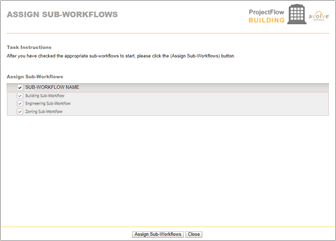
Batch Stamp – This formlet is used to confirm that the user responsible has performed the approval batch stamp. Once this is confirmed, the applicant receives an email which lets them know their final set of plans are now ready for download. This formlet is used for manual batch stamping.

Checklist Report Folder: Specify a valid destination folder path to the checklist report. The format is the following for single level folder or multiple level:
· Approved
· Approved/Checklist
If the folder is specified, a “Generate Checklist Report” button will be visible in the eForm, otherwise the button is not shown on the eForm.
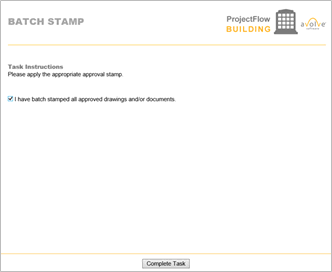
The Simple Batch Stamp activity is configured using a Generic Activity with a Batch Stamp formlet. This activity is a simple way to manually verify the batch stamp process was completed using the ProjectDox Batch Stamp screen.


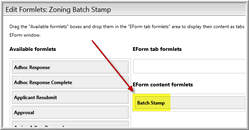
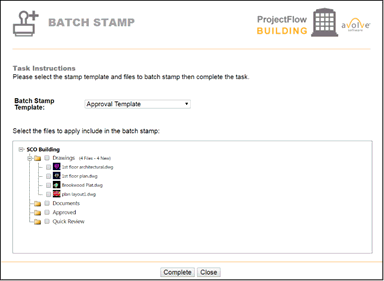
Batch File Stamp Template:
This drop down is a list of all the batch stamp templates configured in the Admin section of ProjectDox.
Select the files to apply the batch stamp:
This is a list of folder and files that need to be batch stamped. Select the ones that apply.Changemark Checklist Info – Used to add the View/Edit Changemark Items and View/Edit Checklist Items to a designated step in the workflow. If the changemark items are not in approved status it should prompt the user with:
"To complete this task all changemarks must be in a completed status."
If the property "ValidateAllChangemarkItemsMet" is checked, then it would require that all changemark items have an approved status before the formlet can be completed. User cannot approve any activity that has the ChangemarkChecklistInforFormlet.ascx formlet if all changemark items are not changed to an approved status. The activity can be rejected but not completed.

Master
Activity:
The
Master Activity drop down displays a list of other activities on the designer.
The value that is configured for this property is the main activity that
any other ChangemarkChecklistInfoFormlet’s are communicating
with and linked to.
Changemarks and Checklists contain comments and discussions between two or more types of users who are completing two or more different steps in the workflow, sometimes a reviewer and applicant or coordinator and applicant, etc. The activity chosen in the Master Activity drop down is a filter to ensure only items created and linked to this master activity will be displayed in the Checklist Viewer and Changemark Viewer. If Master Activity is not selected, i.e. has value “Select One”, the viewer will show items created for all activities with respect to other filters like group, review cycle.

This is typically set to TRUE when ChangemarkChecklistInfoFormlet is added to the Department Review activity. This will allow the Changemark Viewer to automatically filter the Changemarks so the user will see only those Changemarks in the current reviewer group. The user can still change Group filter to another group or “All” groups.
Can Edit Changemark Item Coordinator
Comments
If this configuration is checked [= TRUE], the user will be able to edit
the “Coordinator Comments” on the Changemark Viewer, otherwise it will
be disabled.

Can Edit Changemark Item Reviewer
Comments
If this configuration is checked [= TRUE], the user will be able to
edit the “Reviewer Comments” on the Changemark Viewer, otherwise it will
be disabled.

Can Edit Changemark Item Groups
If this configuration is checked [= TRUE], the user will be able to change the “Department” groups on the Changemark Viewer, otherwise it will be disabled. The Department group can only be changed if the Changemark is owned by the current user. The groups can only be changed to a different group if the current user is in the other group and the other group has a Changemark in the review cycle for the Changemark that is being edited.
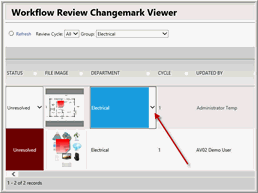
Can Edit Changemark Item Status
If this configuration is checked [= TRUE], the user will be able to edit the “Status” on the Changemark Viewer, otherwise it will be disabled.

Can Edit Changemark Item Applicant Response
If this configuration is checked [= TRUE], the user will be able to edit the “Applicant Response” on the Changemark Viewer, otherwise it will be disabled.

Show All Changemark Items
If this configuration is checked [= TRUE], the user will be able to see all Changemarks from all users and all groups in all sub-workflows and review processes in the workflow. If this is checked, it cancels the effect of selected Master Activity and does not filter the Changemark Viewer
Show Changemark Item Button
If this configuration is checked [= TRUE], the “View/Edit Changemark Items” will be displayed, otherwise it will be hidden.

Validate All Changemark Items Met
All tasks for the activity where the “Changemark Checklist Info” formlet is used cannot be completed until all the Changemark statuses are resolved (i.e. of type “Is Complete Type”).

Changemark Exclusion Folder List
The system will not pull any of the changemarks into the corrections list for any folder that is listed, and exclude from any of the reports. This allows a customer to have a folder that is not exposed, through the use of permissions, to an applicant and will keep the changemarks from showing up on the grid as well.
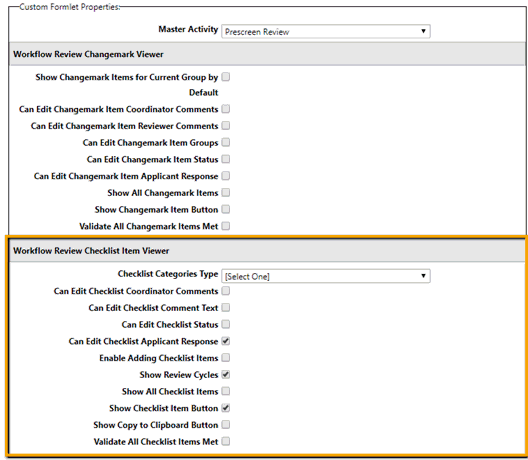
Checklist
Categories Type
The ChangemarkChecklistInfoFormlet will contain this new formlet property.
This formlet property is an additional category filter that will be used
in the Checklist Viewer to ensure that only specific checklist items show
up when the user needs to add checklist items to a checklist items conversation.
This property will be a drop down populated with the new Checklist Categories
Type that will be used in the checklist item conversation allowing the
user to more easily view a smaller subset of items to add. This will allow
the user to quickly add the checklist items needed for the workflow so
they can more quickly finish the task of communicating the checklist items
to the applicant. By default, there will be two Checklist Category Types
for most workflows, PrescreenReview and DepartmentReview. This Checklist
Category Type is required and must be set, or the Checklist Item Viewer
will not populate the Comment Type and therefore not display any available
checklist items in the top list on the page.
If “Enable Adding Checklist Items” is checked then the “Checklist Categories Type” also should be selected. Otherwise user will see error message, when opening the viewer. If “Enable Adding Checklist Items” is not checked, “Checklist Categories Type” may have [Select One] value.
Typically, the ChangemarkChecklistInfoFormlet used in the Prescreen Review and Prescreen Corrections step will be configured to use the PrescreenReview category and the ChangemarkChecklistInfoFormlet formlet property used in the DepartmentReview step will be configured to use the DepartmentReview category. This is to ensure that when the Checklists Viewer is opened from the Department Review step that the user will only see checklist items that pertain to the Department Review step. This is configured by default, but can be changed.
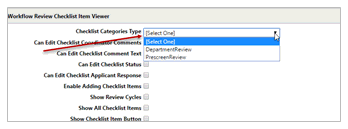
Can Edit Checklist Coordinator
Comments
If this configuration is checked [= TRUE], the user will be able to
change “Coordinator Comments” on the Checklist Viewer. The user must click
the “Done” button to save the change. The user must also be a member of
the Coordinator Group to add or modify Coordinator Comments.

Can Edit Checklist Comment Text
If this configuration is checked [= TRUE], if checked than user will be able to change “Comments Text” on the Checklist Viewer. The user must click the “Done” button to save the change.

Can Edit Checklist Status
If this configuration is checked [= TRUE], if checked than user will be able to change “Status” on a Checklist viewer page. The user must click the “Done” button to save the change.

Can Edit Checklist Applicant Response
If this configuration is checked [= TRUE], the user will be able to change “Applicant Response” on a Checklist viewer page. The user must click the “Done” button to save the change.

Enable Adding Checklist Items
If this configuration is checked [= TRUE], the user will see the list
of available checklist items and will be able to add items to the Selected
Checklist Items list. If this configuration is set to FALSE, user will
not be able to add checklist items. The property “Checklist Category Type”
should also be selected, otherwise user will see an error message.

Show
Review Cycles
If this configuration is checked [= TRUE], the button will be visible,
otherwise it will be hidden. If the Review Cycle button is hidden, the
Selected Checklist Items list will show all checklist items available
in the entire workflow instance regardless of review cycle. If the Review
Cycle drop down is visible and there is active review cycle, the Review
Cycle drop down value will be set to that active review cycle.
Show
All Checklist Items
If this configuration is checked [= TRUE], the Selected Checklist Items
list will show all checklist items essentially cancelling the effects
of Master Activity value. The Selected Checklist Items list will show
checklist items created in all steps of the workflow, regardless of the
Master Activity value.
Show Checklist Item Button
If the "Show All Checklist Items" configuration is checked [= TRUE], all checklist items will be shown in the Selected Checklist Items section of the Checklist Item Viewer regardless of the Master Activity value. The Master Activity value is completely ignored when the "Show All Checklist Items" configuration is [= TRUE].
If the "Show All Checklist Items" configuration is checked [= FALSE] and the Master Activity value is set, the Checklist Item Viewer will show only checklist items created and linked to the master activity.
If the "Show All Checklist Items" configuration is checked [= FALSE] and the Master Activity value is NOT set, the Checklist Item Viewer will not show any checklist items because it’s not configured to show all checklist items and it won't know which activity to use in the query to get the checklist items.
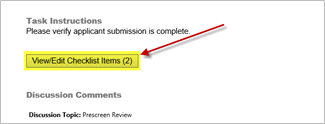
Show Copy to Clipboard Button
Shows the Copy to Clipboard Button in the Available Checklist Items section of the Workflow Review Checklist Item Viewer allowing users to copy the comment text to the clipboard so it can pasted in other parts of the application if needed.

Validate All Checklist Items Met
All tasks for the activity where the “Changemark Checklist Info” formlet is used cannot be completed until all the Checklist items statuses are met (i.e. of type “Is Complete Type”).

Checklist Category types are created in the Workflow Types Manager as seen below.

The user will have to first choose a Permit Type before the Checklist Categories drop down will load. The drop down will be disabled until a Permit Type is chosen. Checklist Category Types can be configured differently for each permit type.
The Checklist Categories Type can only be deleted if it is not being used in any workflow designs or instances. If it is being used, the Is Active checkbox must be unchecked and it will no longer display in the user interface.
The system will be able to report on the conversations that happen during prescreen review or post review using the Checklist Categories Type as a filter to the report.
Each Changemark and each Checklist item now has a unique reference number for the workflow instance. This reference number will be used by the customer to identify each item when discussing the checklists or changemarks with others. This reference number will be the first column in the Checklists Viewer and Changemarks Viewer and the Checklist and Changemark reports.


Copy User to Group – This formlet is used to add a user from one group to another, all within the eForm itself. In order for a particular user to show up as an available choice, they must be a member of the selected source group (the group you have selected for options during configuration). Once this activity is completed, the chosen user will be added to the target group (the group selected during configuration as the one which users are being added to during)
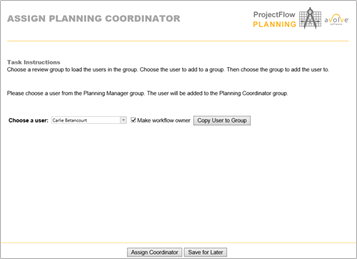
Source Group: Specifies the source group that will contain the user from which to add the target group.
Target Group: Specifies the target group that the user will be added to.
Show Workflow Owner Button:Determines if button “Show Workflow Owner” should be shown.
Title for “Show Workflow Owner” Button: Specify a title for “Show Workflow Owner” button.
Require Target Group Users: Determines if target group should contain at least one user.
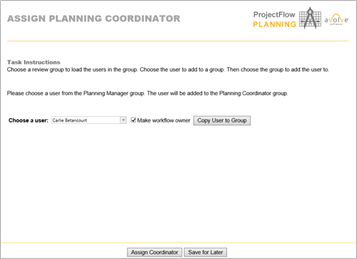
Department Review – A formlet used for the department review step of the workflow. This formlet gives the reviewer access to view and edit changemark items, view and edit checklist items, request additional reviews from other departments, assign reviews to any direct subgroups in the configuration, view the workflow’s history and add comments for the Review Coordinator to see.
The Request Additional Reviews section of the Department Review EForm will be hidden if:
The “Show Request Additional Reviews” formlet property of the Department Review formlet is unchecked. This is checked by default.
If there are no other reviews available to assign.
If the current user opening the EForm is in the root level group of the review configuration.
If the Department Review is not contained inside of an activity grouping with a review configuration set on it.

Discussion Board – A formlet used as a communication tool between participants in the workflow. The comments will be viewable directly on the eForm.

The Discusson Board formlet has three properties:
Topic:
The Topic title is the subject of the discussion. If no Topic title is
entered, an error message will display.
Category:
The Category drop down displays
a list of other activities on the designer. The value that is configured
for this property is the main activity that any other Discussion Board
formlets are communicating with and linked to. The Discusson
Board contains comments and discussions
between multiple groups and users across multiple steps in the workflow
and each one of those discussions must use the same master activity value.
Description:
A description can be added for the discussion topic but is not required.
There will also be a new Discussion Board report called, “Current Project - ProjectFlow Discussion Board Plan Review Report”. This report will show all discussions that happen during the workflow process. It will not show any discussions that are created in ProjectDox.

File Upload - The Applicant Upload screen allows Applicants to upload their electronic plans and other documents during the workflow process using the ProjectFlow eForms. This is deployed on any new BIC workflows definitions; legacy workflows will continue to use the Applicant Upload activity without the file upload formlet. If the customer requests existing workflows to be retrofitted with the “File Upload” formlet it can be added manually in the workflow designer with a services engagement. If manually added then it will only affect new workflow instances created after the change.
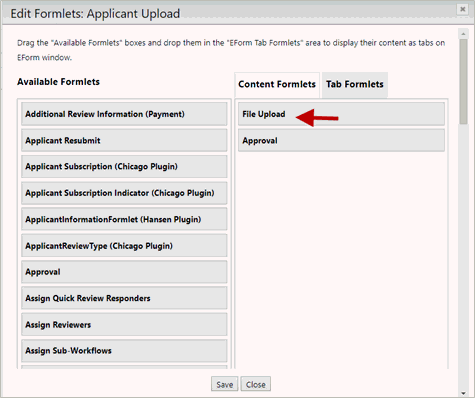
There are no custom properties for File Upload.

The Complete Button text can be customized in any of the three fields shown below. The Action Complete Message is optional. It is a way to communicate to the user that the action is complete and the files have been uploaded.

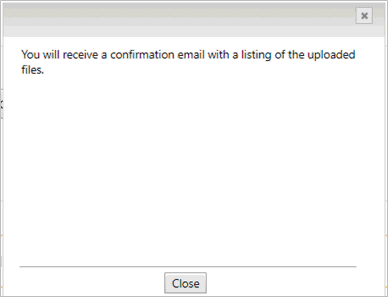
Activity Properties for Applicant upload, Task Completion, Email Notification Template specifies the notifyApplicantUploadTaskCompletion email template. This email can be customized as all other emails in ProjectFlow.
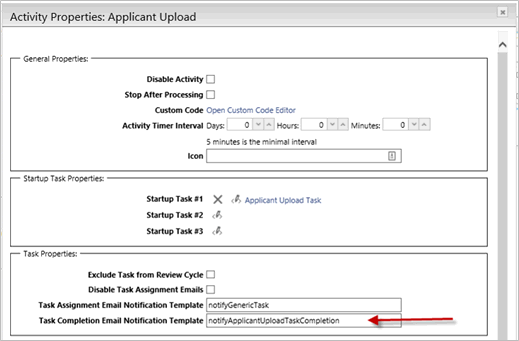
When the form launches, the permissions will determine what folders the applicant will see in this formlet.
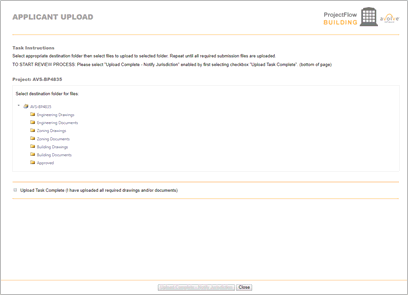
When the user clicks on the folder of choice, the “Select Files to Upload” and “View Folders” button are displayed. Select Files to Upload Clicking this button will open the ProjectDox Upload screen allowing the user to upload any number of files.
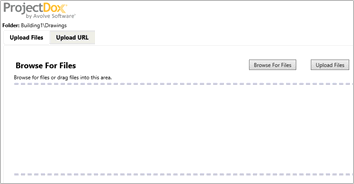
If the user has the permission, the user can also delete files from the folder by clicking on the X icon beside the file.
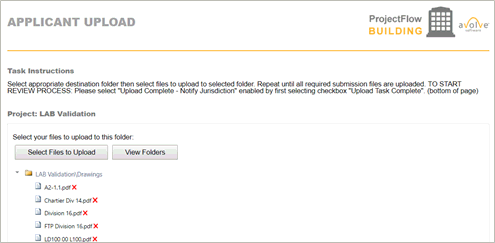
View Folders Clicking this button will display the main folders view allowing the user to choose another folder to upload to.
Once the Applicant checks the checkbox “I have uploaded all required drawings and documents.” then clicks the Upload Complete button, they will receive a confirmation email if configured to do so.

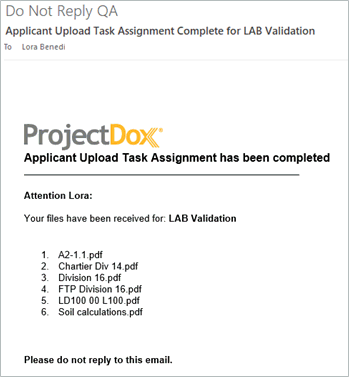
Troubleshooting
Confirm Uploading is operational from the user interface.
Confirm notifyApplicantUploadTaskCompletion.html is in the Custom\en folder of the ProjectDox install.
Confirm user has permissions to desired folders.
Global File Compare – This formlet enables the comparing of files across folders and projects.

1. In the Select Project field under “Open File”, start typing the project name. The search will start auto-populating projects that match.
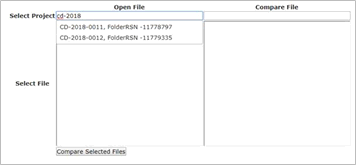
2. Select the desired project. The folders will populate.
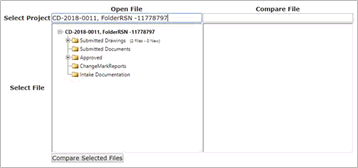
3. Do the same for the Compare File option.
4. Open the folder(s) and select the radio button for the files to compare and Click ‘Compare Selected Files’.
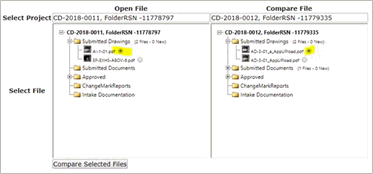
Group Management – This formlet is used to give the user the ability to invite or remove users from their group.
 Once
a user has participated in the review process, they cannot be deleted
from the group.
Once
a user has participated in the review process, they cannot be deleted
from the group.

Monitor Child Workflow Instances - This formlet allow for a view of sub-workflows of a specific workflow definition. This will give the name and status of the activity groupings within the workflow. This is like the Monitor Sub-Workflow activity, but it will not allow the starting of a sub-workflow. It will only give a read-only view of the instances running inside the project and give the ability to terminate a workflow instance.

Monitor Sub-Workflow - A formlet for a persistent task in a PPR workflow that allows the user/group to see the status of all the sub-workflows and all reviews inside of the sub-workflow. In addition, it allows for starting/restarting a sub-workflow.

Project Export - The Export Project activity allows the user to manually or automatically export selected files/folders.
For Manual Project Export, you need to add the “Project Export” formlet into the activity and specify a Startup Task in the activity property of export project activity. The formlet allows the user to select the project Export Template and the list of files to include in the export. Once this task is completed by the user, a scheduled task gets created and the Task ID is placed into the “Scheduled Task ID” activity property. The requesting user will get a notification once the scheduled task is complete.
For the Automated Project Export, you need use the Export Project Activity and specify the following activity properties:
· “Project Export Template Name” to use in the project export,
· “Export Entire Project” which should be checked if exporting entire project
· “Folder Names” (delimited by | pipe symbol) to include in the export, if not exporting entire project
· “Notify Group Name” which is a single valid group name to receive the notification when the project export is completed
Once the activity is executed, a scheduled task gets created and the Task ID is placed into the “Scheduled Task ID” activity property. The task will be completed by the system within 5 minutes of the activity being executed.
Even though the “Scheduled Task ID” is shown on the page, it should not be modified and it is only shown for debugging and tracing purposes.
If an error occurs when processing the scheduled task, the workflow will be on error state and the error log will be displayed on the workflow instance designer as an error log for the activity.
Quick Review Response – A formlet which gives the individual(s) assigned a Quick Review task the opportunity to complete the task and communicate with the initiator of the workflow.

Report Viewer – This formlet allows the configuration of a single report to display in the eForm. Any report available in ProjectDox can be used.
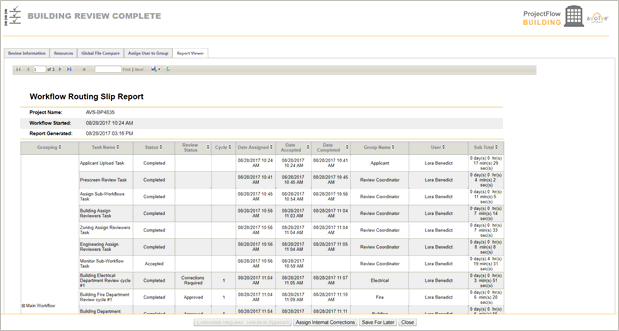
Resources – This formlet is used to provide users any additional resources needed throughout the process of the workflow. HTML can also be used.

Resubmit Received – This formlet is used to review items that have been sent back to other groups and approve them or reject them and send them back for further corrections.
If a department reviewer is found to have made a mistake by the person performing this task, a button will appear that assigns corrections to the needed party.
If an applicant is found to require corrections to their submissions during a department review, a button will appear to assign a task for the applicant to make the needed adjustments.
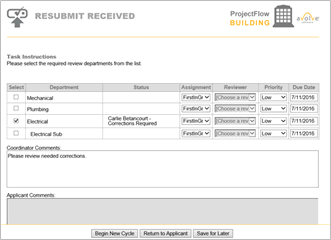
Review Complete - Formlet used to determine if the reviews have been satisfactorily completed and sends the workflow to batch stamp (or next activity) or back to Applicant Resubmit.
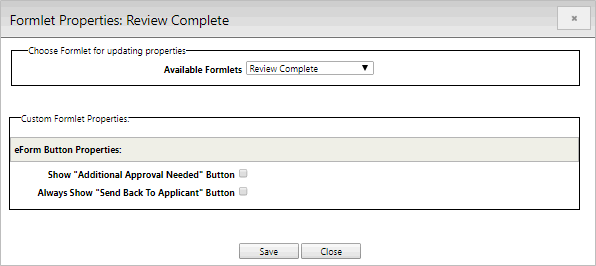
Show “Additional Approval Needed” Button: Determines whether to show the Additional Approval Needed button
Always Show “Send Back to Applicant” Button: Determines whether to always show the Corrections Required – Return to Applicant button or show the button only when there are reviews that are not approved.
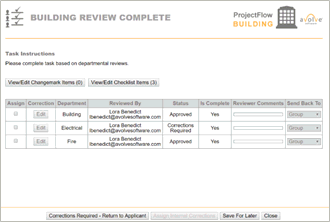
Review Information – This formlet presents the user with information related to the review, as well as what login is being currently used.
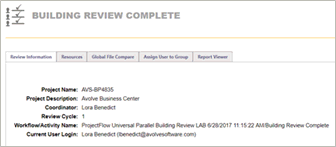
The Scheduled Batch Stamp activity is configured using a Scheduled Batch Stamp Activity with or without a Scheduled Batch Stamp Formlet.
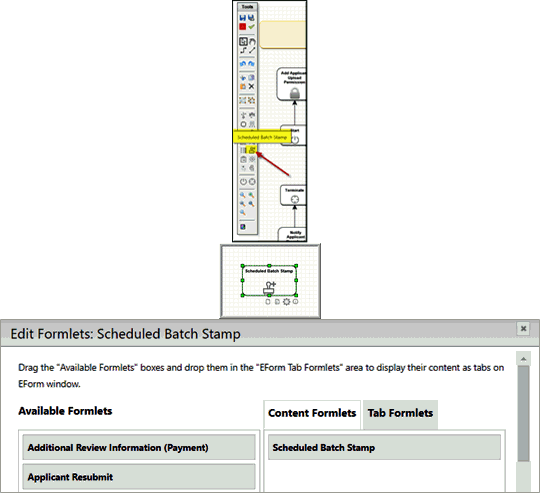
This formlet property configuration allows the user to specify a project folder to output a Checklist Report. When this value is populated, a button named "Generate Checklist Report" will be displayed in the formlet. When the button is clicked, a checklist report will be generated as a PDF and will be uploaded into the project folder specified in the setting. This can be used for the Simple Batch Stamp and Scheduled Batch Stamp activities.
The format accepts a single level folder or multiple levels:
Approved
Approved/Checklist
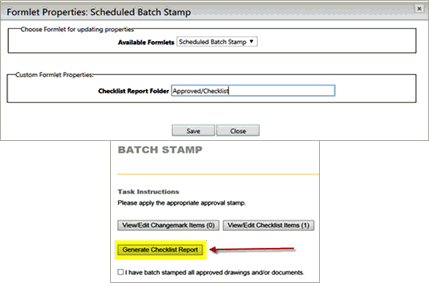
For Manual activity, add the “Scheduled Batch Stamp” formlet into the activity and specify a StartUp Task in the activity property.
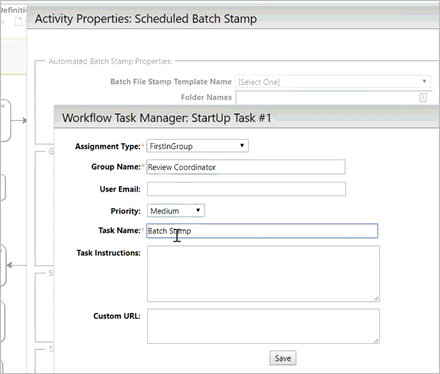
The formlet allows the user to select the batch stamp template and the list of files to batch stamp. Once this task is completed by the user, a scheduled task gets created and the Task ID is placed into the “Scheduled Task ID” activity property. The requesting user will get a notification once the scheduled task iscomplete.
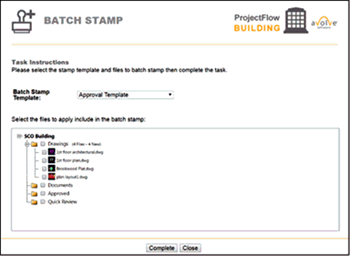
For the Automated activity property, the start-up task is not required, but you do need to specify the activity properties and ensure you use the Scheduled Batch Stamp formlet for the activity.
The Scheduled Batch Stamp activity is a batch stamp process that uses a scheduled task in the ProjectDox Task Scheduler. Even though the “Scheduled Task ID” is shown on the Properties page, it should not be modified, and it is only shown for debugging and tracing purposes.
If an error occurs when processing the scheduled task, the workflow will be in error state and the error log will be displayed on the workflow instance designer.

This drop down is a list of all the batch stamp templates configured in the Admin section of ProjectDox.
This is a pipe-delimited list of folders to be stamped. Every document in each folder will be stamped.
Specify a valid Group Name for the Project that will receive an email notification when the automated batch stamp is completed or when errors occur.
This is used for debugging purposes and for technical support. It is a read-only property and cannot be modified. When the task starts to run, the Scheduled Task ID will be assigned.

In ProjectDox, Admin, Configuration, Batch Stamp tab specifies the number of files to be submitted in a single batch in the first entry BatchStampFileCount.

If your jurisdiction normally stamps, 250 files for instance, this value can be 250 and the files will be sent to publish immediately when the workflow engine runs.
Customers that batch stamp 4000 files will want to test their system resources and determine the best value. If the customer sets the value at 4000, the files will take priority and all other uploaded files. The Applicant for instance, would have to wait until the 4000 files complete, this is not best practice. The recommended starting value is 50 to 250 in the BatchStampFileCount.
PDReserved@<JurisdictionEmail>.com is created during ProjectDox installation and used for the purpose of running web services and identification in the ProjectDox log. PDReserved email ensures that the user’s employment status or name change does not impact automated processes. This user must remain active and have SA user permissions. No user logs in with this email; it is only used to run web services and is written to the database log.

Once the activity is executed, a scheduled task gets created and the Task ID is placed into the “Scheduled Task ID” activity property. The task will begin publishing the BatchStampFileCount every 5 minutes. There are two different tasks – the “Workflow Engine” task that runs the workflow engine every few mins and the “Batch Stamp” task that processes a batch stamp.

The ProjectDox Utility web.config, configuration default is 300 seconds which is equivalent to 5 minutes and the value can be edited, but no less than three (3) minutes.
<add key="SecondsBetweenInvoke" value="300" />
<!-- how many seconds between when web services/processing are invoked, recommended is 300 - 600 seconds (5 - 10 minutes) -->
If the batch stamp errors or the scheduled task times out, this will put the ProjectFlow activity into an error state. The workflow recovery process could consist of the following options:
User will see the error for the batch stamp activity in the designer as the activity will be red and the error will list the files that were published successfully and the ones that failed.
User will fix the error.
User can go into the Approved folder in ProjectDox and delete all the files then go back to ProjectFlow and jump to clear the current Scheduled Task ID. This will reactivate the batch stamp activity and allow the user to run the batch stamp again.
The batch stamp scheduled task will notify the designated group when the batch stamp process is complete and the activity is completed.

![]()